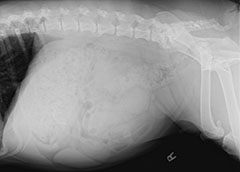Pyometra is an infection of the uterus that may occur in dogs and cats making the pet very ill. The uterus is generally filled with pus. Although the disease has been recognized for decades, the true disease process has still not been completely understood. It is generally recognized that progesterone and estrogen and their receptors have a role in the development of pyometra; however, the infection is triggered by bacterial involvement.
The cyclical hormonal influences of the female dog and cat allow the uterus to go through changes that will be acceptable for fertilization of an embryo. If bacteria are introduced into the uterus at a certain time during the cycle, hormonal regulation of the uterus allows the infection to start and become life-threatening. The bacteria typically cultured from the uterus are bacteria that would be found in the areas of the intestines and vagina (E. coli is the most common). Therefore, many of the infections are considered either from an ascending infection from the vagina, a concurrent urinary tract infection, or fecal contamination.
Most dogs and cats that are spayed early in life will not develop pyometra. However, a uterine stump pyometra may occur after incomplete ovariohysterectomy which allows a segment of the uterine body or horn to become infected. Typically, either a portion of the ovarian tissue is still present or the animal has been subjected to progestational hormones to allow this situation to develop.
Because the infection can be so severe, the signs your pet may show are not limited to the genital tract. Your pet can become so overwhelmed by the inflammation associated with the infection that the uncontrolled inflammatory process may be life-threatening.
The most common clinical signs in dogs and cats are:
- lethargy
- depression
- anorexia
- excessive water intake
- excessive urination
- pale mucous membranes
- bloody vaginal discharge
Vomiting, diarrhea, weight loss, abdominal distension, and inflamed eyes have been reported less frequently. Some pets may have no clinical signs other than purulent vaginal discharge. Pyometra should be considered in any intact female dog that is sick.
Many dogs and cats will have a closed cervix and therefore the obvious sign of bloody vaginal discharge may not be present.
Your primary-care veterinarian may suspect the diagnosis based on your history and your pet’s physical exam. If the cervix is not open, the diagnosis may take a few more diagnostic tests. In general, a fluid distended uterus is needed to diagnose pyometra. Your veterinarian will likely recommend the following diagnostic tests to help diagnose pyometra:
- general chemistry profile
- complete blood count
- urinalysis
- abdominal radiographs
- abdominal ultrasound
- vaginal cytology
Radiographs are typically very suggestive but abdominal ultrasounds will typically identify the fluid filled uterus (Figure 1).

Pyometra is a medical emergency that requires rapid intervention to prevent overwhelming infection and death. For most pets, preoperative stabilization and resuscitation are first and foremost. After appropriate stabilization, ovariohysterectomy (spay) is the therapy of choice. The results of this therapy are generally a rapid recovery with minimal risk of recurrence. Ovariohysterectomy also negates the risk of ovarian and uterine cancer and future unwanted pregnancy.
Although surgery is the therapy of choice, very special case selection meeting certain criteria may allow valuable breeding animals to be treated medically. However, in addition to the previously mentioned multiple organ problems, the dogs will generally exhibit abdominal pain, excessive vomiting/ defecation, high heart rates, salivation, breathing difficulties, panting, and fever with medical management. It takes several days until an effect is seen when treating pets with pyometra with injectable prostaglandins and antibiotics. Dogs and cats are susceptible to developing pyometra again after medical treatment and should have an ovariohysterectomy performed when their breeding purposes are finished.
Once your pet is discharged from the hospital, the aftercare is minimal. The care is generally the same as it would be for a routine spay; however, your pet will be on antibiotics as prescribed by your veterinarian for at least 10 days. The animal should not be allowed have normal play, stairs, or any off-leash activities for the first two weeks after surgery, and the incision should be protected from self-trauma.
The prognosis for survival with ovariohysterectomy can be as high as 80–100% if abdominal contamination is avoided and the systemic infection is treated and responds appropriately. However, if severe sepsis and organ failure develops, the prognosis can be less favorable. Rare pets may have persistently increased urination and water intake and a state of permanent kidney damage.












